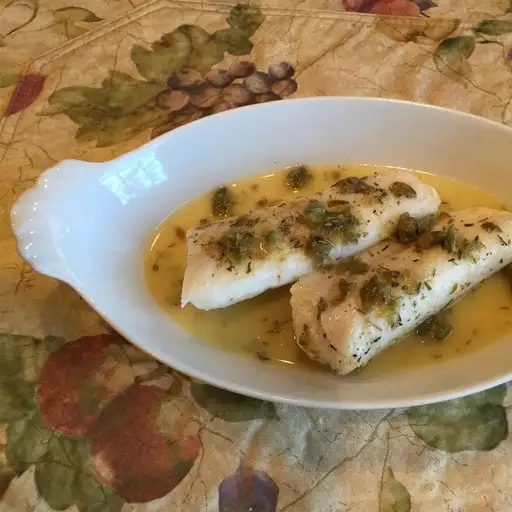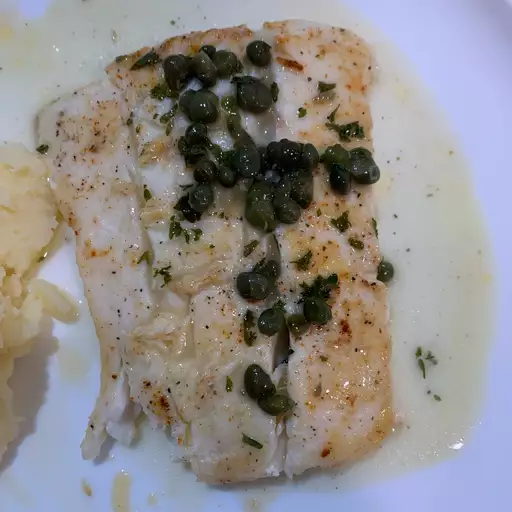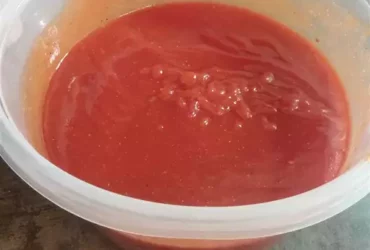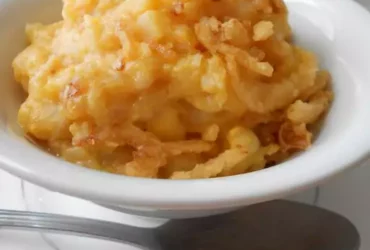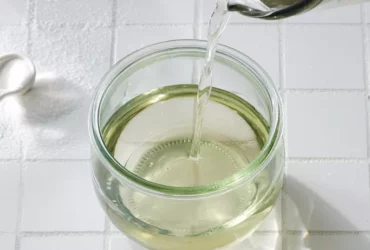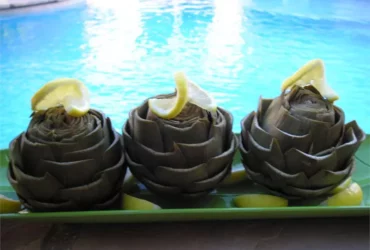Ingredients
For the Lemon Caper Butter Sauce
The Lemon Capper Butter Sauce recipe requires several key ingredients to achieve its tangy and rich flavor profile. The essential components include
Lemons
Freshly squeezed lemon juice adds a bright, citrusy note to the sauce. Use about 2-3 tablespoons of freshly squeezed lemon juice per serving.
Butter
Unsalted butter provides richness and creaminess to the sauce. Melt 1/4 cup (55g) of unsalted butter for each serving you plan to make.
Capers
These small, pickled flower buds bring a salty, tangy flavor to the dish. Use about 2 tablespoons of capers per serving, rinsed and drained.
Garlic
Mince 1-2 cloves of garlic depending on your personal preference for its intensity.
Parsley
Fresh parsley adds freshness and color to the sauce. Chopped parsley or parsley leaves can be used, about 1 tablespoon per serving.
Salt and Pepper
Season with salt and pepper to taste to balance out the flavors in the sauce.
Optional ingredients
Dill
Add a hint of fresh dill flavor by mixing in some chopped fresh dill or dill weed, about 1 teaspoon per serving.
Ginger
For an Asian twist, grate some ginger (about 1/4 teaspoon per serving) and add it to the sauce for an added depth of flavor.
The success of any sauce, including this Lemon Caper Butter Sauce recipe, heavily relies on the quality and freshness of its ingredients.
Lemons are an essential component, providing a burst of citrus flavor to balance out the richness of the butter and capers.
For optimal results, use fresh lemons with bright, acidic juice that will add depth to the sauce without overpowering it.
Capers, on the other hand, bring a salty, slightly tangy flavor that complements the lemon nicely.
The best type of caper to use in this recipe is nonpareil capers, which are smaller and have a milder flavor compared to other varieties such as surper or capote.
Unsalted butter is another crucial ingredient, providing richness and creaminess to the sauce without adding excess salt.
Choose high-quality, European-style unsalted butter with a higher fat content for a more luxurious texture and flavor.
Garlic and shallots are used to add a pungent aroma and depth to the sauce.
Minced garlic is ideal in this recipe because it dissolves quickly into the butter, releasing its flavors without overpowering the other ingredients.
Fresh shallots have a sweeter flavor compared to dried or powdered ones and are essential for adding an oniony undertone to the sauce.
Parsley, thyme, and chives add freshness and fragrance to the sauce, rounding out the overall flavor profile.
Use chopped fresh herbs like parsley and chives for a burst of color and added flavor in each bite.
Thyme is used sparingly because its potent flavor can easily overpower the other ingredients.
This Lemon Caper Butter Sauce recipe requires very few ingredients, but their quality and freshness are crucial to achieving the desired result.
The combination of these carefully selected ingredients will yield a rich, creamy, and flavorful sauce perfect for accompanying steamed vegetables, pasta, or seafood dishes.
2 tablespoons unsalted butter, softened
The first ingredient required for this recipe is two tablespoons of unsalted butter. It’s essential to note that the butter should be softened before use.
This ensures that it easily melts and blends with other ingredients in the sauce, creating a smooth texture.
List of properties for softened unsalted butter
- Softened butter is easier to mix and blend with other ingredients.
- It’s more likely to melt evenly when heated, which prevents lumps in the sauce.
- The softness also helps it dissolve into a uniform consistency.
Using softened unsalted butter allows for better emulsification and blending with acidic ingredients like lemon juice and capers in the recipe. The result is a balanced and creamy Lemon Caper Butter Sauce that’s ideal for serving with pasta, vegetables, or as a side dish.
2 cloves garlic, minced
The ingredient list for our Lemon Caper Butter Sauce recipe begins with a fundamental component that sets the stage for the entire dish – 2 cloves garlic, minced.
Garlic, when used in cooking, is not just about flavor, but also about aroma and texture. In this specific context, it serves to add depth and warmth to our sauce, balancing out the brightness of the lemon juice.
The process of mincing 2 cloves of garlic involves first peeling them and then using a sharp knife or a specialized tool to finely chop the resulting cloves into small, uniform pieces. This method allows for even distribution of the garlic’s flavors throughout the dish.
It is essential to note that when working with garlic, especially when it’s minced, it’s often necessary to handle it gently to avoid crushing or bruising the delicate cells that contain its flavor and aroma compounds. Over-processing can result in an unpleasant, bitter taste due to the release of these volatile compounds.
When preparing our Lemon Caper Butter Sauce recipe, the addition of garlic is done at a stage where it will have time to meld with the other ingredients without becoming overpowering. The heat from the cooking process also helps in breaking down the molecules that contribute to its flavor, allowing them to blend harmoniously within the sauce.
2 lemons, juiced
The key to making a great Lemon Caper Butter Sauce is starting with high-quality ingredients, particularly when it comes to the two lemons that are juiced.
Lemons provide a bright and citrusy flavor to the sauce, which pairs perfectly with the rich butter and capers.
For the best results, choose lemons that are heavy for their size, have a smooth, thin skin, and give off a sweet, citrusy aroma.
Avoid using lemons that are green or have soft spots, as they may be unripe or spoiled.
Pantry Staples
- Butter: We recommend using high-quality, salted butter for this recipe. You can use either European-style or American-style butter.
- Capers: These are the pickled flower buds of a Mediterranean plant. Look for capers that are packed in brine and have not been preserved with vinegar.
- Garlic: Fresh garlic is essential for this recipe. Choose heads that are firm, dry, and have no signs of mold or sprouting.
- Olive oil: A neutral-tasting olive oil is perfect for sautéing the capers and garlic.
Additional Ingredients
- Black pepper: Freshly ground black pepper adds depth and complexity to the sauce.
- Honey or sugar: A small amount of honey or sugar balances out the acidity of the lemons.
- Chopped fresh parsley or dill: These herbs add a bright, fresh flavor to the finished sauce.
When juicing the lemons, be sure to use a manual or electric juicer to extract as much juice as possible.
You can also use a fine-mesh sieve to strain the lemon juice and remove any seeds or pulp.
Lemon Juice Tips
- Use only freshly squeezed lemon juice for the best flavor.
- Aim for about 2-3 tablespoons of lemon juice per cup of sauce.
- If you prefer a stronger or weaker lemon flavor, adjust the amount to suit your taste.
With these high-quality ingredients and careful juicing technique, your Lemon Caper Butter Sauce will be sure to impress!
1/4 cup capers, rinsed and drained
Capers are a key ingredient in this recipe, and it’s essential to use high-quality ones that are fresh and have a good flavor. The recipe calls for 1/4 cup of capers, which may seem like a small amount, but trust us, it makes all the difference in the world. The first step is to rinse the capers under cold water to remove any excess salt or moisture.
This is crucial because capers can be quite salty, and you want to balance out that flavor with the other ingredients in the recipe. Once they’re rinsed, drain them well and pat them dry with a paper towel to remove as much moisture as possible. This will help prevent the sauce from becoming too watery or soggy.
The capers should be nice and plump after rinsing and drying, which is perfect for this recipe. You want them to retain their texture and flavor so that they can add a burst of salty goodness to the sauce. If you’re using a jarred caper product, make sure it’s well-drained before using it in the recipe.
When you’re ready to use the capers, simply chop them up finely with a knife or use a food processor to get them into small pieces. This will help them distribute evenly throughout the sauce and prevent any lumps from forming. You can also use a microplane grater to grate the capers for added texture.
1 tablespoon chopped fresh parsley
In the context of a delicious and aromatic Lemon Caper Butter Sauce, one essential ingredient that adds freshness and fragrance to the dish is 1 tablespoon chopped fresh parsley.
Parsley is a popular herb used in many culinary traditions around the world, and its uses go beyond just adding color to a dish. It has a mild, slightly bitter taste and a refreshing aroma that pairs well with the bright, citrusy flavors of lemon and capers.
When it comes to using parsley in cooking, freshness is key. You want to use the freshest leaves possible to get the best flavor and texture. Here’s how to choose the right parsley for your Lemon Caper Butter Sauce
Selecting Fresh Parsley
- Choose parsley with vibrant green leaves and no signs of wilting or yellowing.
- Avoid parsley that has been sitting out at room temperature for too long, as it can lose its flavor and aroma quickly.
- Parsley can be stored in the refrigerator to keep it fresh for longer. Wrap the stems in a damp paper towel and place them in a plastic bag or airtight container.
How to Chop Fresh Parsley
- Rinse the parsley leaves under cold running water, and pat them dry with a paper towel.
- Cut off the stems from the leaves using kitchen shears or scissors. You can use just the leaves for this recipe, but save the stems to make a delicious vegetable broth later.
- Chop the parsley leaves into small pieces using a sharp knife or kitchen shears. You want them to be roughly the same size as the capers in the sauce.
Using Parsley in the Lemon Caper Butter Sauce
- Add the chopped parsley to the saucepan with the lemon juice, butter, and capers towards the end of cooking time. This will help preserve its flavor and aroma.
- Stir gently to combine the ingredients and allow the flavors to meld together for a few minutes before serving.
In conclusion, 1 tablespoon chopped fresh parsley is an essential ingredient in the Lemon Caper Butter Sauce recipe, adding freshness, fragrance, and flavor to the dish. By choosing the right type of parsley, chopping it properly, and using it at the right time, you can elevate your cooking skills and impress your loved ones with this delicious and aromatic sauce!
Salt and pepper to taste
The key to achieving a well-balanced flavor in the Lemon Caper Butter Sauce recipe lies in the judicious use of its core ingredients.
At the heart of any great sauce is the combination of fat, acidity, and umami flavors
The rich, creamy base of this sauce comes from a generous helping of unsalted butter, which serves to add depth and body to the final product.
For those who prefer a slightly lighter take on this sauce, you may want to consider using a combination of melted butter and neutral-tasting oils such as canola or grapeseed.
Once your fat component is in place, it’s time to address the crucial role that acidity plays in balancing out the flavors within this dish. Here, fresh lemon juice serves to cut through the richness of the butter while also lending its bright citrus flavor to the sauce.
You’ll want to use a good quality of freshly squeezed lemon juice for this recipe, as any artificial or subpar substitutes may result in an unbalanced flavor profile. Be sure to reserve a pinch of the lemon zest from your chosen citrus fruit as well, as we’ll be using it later on.
With our fat and acidity components now in place, it’s time to turn our attention to the third major component of this sauce: its savory umami flavors
In addition to salt and pepper to taste, which will help round out the flavors of this dish, we’re also going to add some chopped capers for their tangy salty kick.
These small pickled flower buds pack a big punch when it comes to flavor, adding an assertive salty and slightly sour note to our sauce. Be sure not to overdo it on these tiny morsels, however, as too much caper can quickly overwhelm the other flavors in your dish.
To round out this comprehensive guide to ingredients for Lemon Caper Butter Sauce, we should also briefly discuss the role of salt and pepper to taste.
The key here is to remember that these two seasonings are meant to enhance rather than dominate the other flavors at play within your sauce. With that in mind, it’s generally best to add small amounts of both salt and pepper throughout the cooking process, tasting frequently as you go to adjust the seasoning accordingly.
The key to creating an exceptional Lemon Caper Butter Sauce lies in selecting the finest and freshest ingredients.
Essential Ingredients
- Lemons: Freshly squeezed lemon juice is a crucial component of this recipe. Use organic, unsweetened lemons for optimal flavor.
- Unsalted Butter: High-quality, salt-free butter provides a rich and creamy base for the sauce.
- Capers: Choose high-quality capers in brine or nonpareil to add a burst of salty, tangy flavor.
- Garlic: Freshly minced garlic enhances the overall flavor profile of the sauce without overpowering it.
In addition to these essential ingredients, several secondary components elevate the Lemon Caper Butter Sauce
Secondary Ingredients
- White Wine: A dry white wine adds depth and a hint of acidity to balance out the richness of the butter.
- Dijon Mustard: This type of mustard provides a tangy, slightly spicy flavor that complements the lemon and capers.
- Fresh Parsley: Chopped parsley adds a pop of freshness and color to the dish, as well as a hint of herbal flavor.
Finally, a few pantry staples are necessary to complete the sauce
Pantry Staples
- Salt-Free Seasoning Blend: A pinch of this blend enhances the overall flavor without adding excess salt.
- Freshly Ground Black Pepper: A few grinds of black pepper add a subtle depth to the dish.
Instructions
Making the Sauce
To make the Lemon Caper Butter Sauce, you will need to follow these steps
Step 1: Make the Compound Butter
- Start by making a compound butter that combines softened butter with lemon zest, juice, and chopped capers.
- In a medium-sized bowl, use an electric mixer to cream together 1/2 cup (110g) of softened unsalted butter until it’s light and fluffy.
Step 2: Add the Lemon Zest, Juice, and Capers
- Add 2 tablespoons of freshly squeezed lemon juice, 1 tablespoon of finely chopped fresh capers, and 1 teaspoon of grated lemon zest to the bowl with the softened butter.
- Mix until well combined, ensuring that the citrus and caper flavors are evenly distributed throughout the butter.
Step 3: Add the Garlic and Shallots
- Add 2 cloves of minced garlic and 1 tablespoon of finely chopped shallots to the bowl with the lemon-caper butter mixture.
- Mix until well combined, ensuring that the garlic and shallot flavors are evenly distributed throughout the sauce.
Step 4: Season the Sauce
- Add a pinch of salt and pepper to the bowl with the lemon-caper butter mixture.
- Mix until well combined, ensuring that the seasoning is evenly distributed throughout the sauce.
Step 5: Chill and Serve
- Cover the bowl with plastic wrap and refrigerate the lemon-caper butter sauce for at least 30 minutes to allow the flavors to meld together.
- Serve chilled, garnished with chopped fresh herbs or edible flowers if desired.
Optional
- If you want a lighter sauce, you can add a little more lemon juice or water to thin it out.
- If you prefer a thicker sauce, you can melt an additional 1-2 tablespoons of butter and whisk it into the mixture.
Tips
The key to making great sauce is to use high-quality ingredients, such as fresh lemons and capers.
Also, make sure to store any leftover sauce in an airtight container in the refrigerator for up to 5 days.
The effectiveness of any recipe largely depends on the clarity and precision of its instructions. In the case of the Lemon Caper Butter Sauce Recipe, a well-written set of instructions can guide the cook through the preparation process with ease.
When creating a recipe like the Lemon Caper Butter Sauce, it is crucial to consider the sequence in which ingredients should be added to avoid any unwanted flavors or textures. The first step might involve preparing the butter by melting it until it reaches a smooth consistency.
The next steps would typically involve incorporating the lemon juice and zest into the melted butter, followed by the addition of capers for their distinctive flavor. Seasoning with salt and pepper can then be added to balance out the dish.
To ensure that the sauce doesn’t curdle or separate during cooking, it’s advisable to continuously heat it gently while stirring. The addition of any other ingredients at this stage, such as chopped herbs, should also be done with caution.
The final step might involve tasting and adjusting the seasoning before serving. It is crucial to follow each instruction carefully to avoid ruining the sauce or creating an unpleasant flavor profile.
Moreover, clear instructions in a recipe like Lemon Caper Butter Sauce Recipe can also provide insight into the underlying chemistry that takes place when ingredients are combined. For instance, the use of butter as a base allows for a rich and creamy texture, which is then enhanced by the addition of lemon juice for its acidity.
In conclusion, clear instructions play a pivotal role in ensuring that any recipe, including the Lemon Caper Butter Sauce Recipe, is executed successfully. By paying close attention to each step and following the sequence of ingredient addition precisely, cooks can achieve a dish that not only tastes great but also looks visually appealing.
Melt butter in a medium saucepan over low heat.
To begin making this delectable lemon caper butter sauce, it’s crucial to start by melting a quantity of butter in a medium-sized saucepan over low heat.
This initial step may seem straightforward, but it lays the foundation for the rest of the recipe.
The heat should be set to a minimum, ensuring that the butter doesn’t burn or reach its smoke point too quickly.
A general rule of thumb is to use unsalted butter for this recipe, as salted butter may overpower the delicate flavors of the lemon and capers.
As you wait for the butter to melt, take a moment to prepare any additional ingredients needed for the sauce, such as fresh lemons, white wine, chicken broth, capers, and chopped fresh parsley or dill.
Once the butter has melted completely, it will start to simmer gently, filling the saucepan with a rich, velvety aroma.
This is an excellent opportunity to adjust the heat as needed to maintain a steady simmer, allowing the flavors to meld together harmoniously throughout the cooking process.
The key to achieving success in this recipe is to cook each component slowly and patiently, allowing the delicate flavors of the lemon, capers, and herbs to shine through without overpowering one another.
Add garlic and cook, stirring occasionally, for 45 minutes or until fragrant.
The addition of garlic to a dish not only adds flavor but also serves as a preservative and digestive aid.
To add garlic to the lemon caper butter sauce, you’ll need to mince 2-3 cloves, depending on your desired level of garlickiness.
Begin by finely chopping or crushing the garlic using a garlic press, knife, or food processor to release its oils and flavor.
Add the minced garlic to the pan containing the butter sauce mixture and cook over medium heat for 45 minutes or until fragrant.
This is an essential step in allowing the flavors to meld together and the garlic to caramelize slightly, resulting in a rich and complex sauce.
Stirring Occasionally
Throughout this cooking process, it’s crucial to stir the mixture occasionally to ensure even heat distribution and prevent burning or scorching of the butter or garlic.
Tips for Achieving the Perfect Garlic Flavor
- Mince fresh garlic: Freshly minced garlic releases its flavors more evenly than pre-minced or powdered garlic, making it an ideal choice for this sauce.
- Cook at the right temperature: Cooking at a medium heat helps prevent burning and caramelizes the garlic evenly, resulting in a deeper flavor profile.
- Add other aromatics: Consider adding other aromatics like onions or shallots to complement the garlic’s pungency.
By following these tips and allowing the garlic to cook for 45 minutes, you’ll be able to create a rich and aromatic lemon caper butter sauce that elevates your dish to new heights.
Add lemon juice, capers, and parsley. Stir to combine.
When it comes to preparing a Lemon Caper Butter Sauce recipe, following clear and concise instructions is crucial for achieving the desired flavor and texture. The addition of lemon juice, capers, and parsley not only enhances the taste but also adds a burst of freshness and visual appeal to the dish.
To incorporate these ingredients effectively, begin by squeezing fresh lemon juice over the sauce. This will introduce a bright, citrusy note that complements the richness of the butter. Make sure to use high-quality lemons for the best flavor.
Next, add capers to the sauce. These small pickled flower buds pack a big punch in terms of flavor and texture. Use about 1-2 tablespoons of chopped capers depending on your desired level of caper intensity. You can also rinse them briefly under cold water to remove excess salt before adding.
After incorporating the lemon juice and capers, sprinkle some chopped parsley over the top. This will not only add a pop of color but also infuse the sauce with a slightly bitter and herbaceous flavor that balances out the other components.
To combine these ingredients seamlessly, stir the mixture gently. You can use a whisk or a spoon to mix everything together, being careful not to create too much foam. The goal is to distribute the lemon juice, capers, and parsley evenly throughout the sauce without introducing any air pockets that might affect its consistency.
As you stir, pay attention to the balance of flavors in your Lemon Caper Butter Sauce recipe. Taste it regularly and adjust the seasoning as needed. This will ensure that the final product has a harmonious and well-balanced taste profile that complements the dish it’s accompanying.
Season with salt and pepper to taste.
To season the Lemon Caper Butter Sauce with salt and pepper to taste, follow these steps
- Add a pinch of salt to the sauce to enhance its flavor.
- Taste the sauce as you go and adjust the amount of salt according to your preference. Some people like their food more salty while others prefer it less so.
- Follow up with a few grinds of freshly ground black pepper. Black pepper has a slightly bitter taste that complements the acidity in the lemon juice.
- Taste the sauce again and adjust the amount of black pepper as needed. Remember, you can always add more but it’s harder to remove excess pepper from the sauce.
When seasoning with salt and pepper, remember that a little goes a long way. It’s better to err on the side of caution and start with small amounts before adjusting to taste. This ensures that your Lemon Caper Butter Sauce is perfectly balanced and deliciously flavorful.
The key to mastering any recipe lies in clear and concise instructions that guide you through each step with precision and ease. In this article, we will delve into the world of instructions, exploring the importance of clarity, specificity, and sequencing in cooking recipes.
When it comes to a Lemon Caper Butter Sauce Recipe, the instructions must be step-by-step, allowing even the most novice cook to follow along without getting lost. A well-written set of instructions will include all necessary information, from measuring ingredients to techniques and cooking methods.
The first step in creating an effective recipe is to list all the required ingredients with their corresponding measurements. For a Lemon Caper Butter Sauce Recipe, this may include
- 2 tablespoons unsalted butter
- 1/4 cup freshly squeezed lemon juice
- 1 tablespoon capers, rinsed and chopped
- 1 clove garlic, minced
- Salt and pepper to taste
With the ingredients identified, the instructions should then outline the sequence of steps necessary to prepare the sauce. This may involve
- Meltting the butter in a skillet over medium heat
- Adding the garlic and cooking until fragrant
- Pouring in the lemon juice and stirring to combine
- Stirring in the capers and seasoning with salt and pepper to taste
The sequence of these steps is crucial, as it ensures that each component is added at the right moment to achieve the desired flavor and texture. For example, adding the garlic before the lemon juice allows the flavors to meld together smoothly.
A good set of instructions will also provide additional tips and recommendations for customizing the recipe to suit individual tastes. This might include suggestions for varying the amount of lemon juice or adding other ingredients, such as herbs or spices.
In conclusion, clear and concise instructions are essential in any recipe, particularly one as complex and nuanced as a Lemon Caper Butter Sauce Recipe. By following these guidelines, cooks can create a dish that is not only delicious but also easy to prepare and customize to their liking.
Serving Suggestions
Pairing the Sauce
This vibrant and flavorful lemon caper butter sauce can elevate various dishes and add a burst of citrusy freshness to your meals. When it comes to serving suggestions, pairing this sauce with suitable ingredients can create a harmonious balance of flavors.
One classic combination is to pair the lemon caper butter sauce with pan-seared fish or seafood such as salmon, cod, or shrimp. The bright and zesty notes in the sauce complement the delicate flavor of the fish, creating a delightful and refreshing dish.
The sauce also pairs exceptionally well with pasta, particularly those with light and herby flavors like linguine or fettuccine. A simple toss of cooked pasta with the lemon caper butter sauce, some toasted pine nuts, and chopped fresh parsley can make for a quick and satisfying meal.
Another great pairing is with roasted chicken or pork, where the acidity in the sauce helps to cut through the richness of the meat. Simply serve the roasted protein alongside a bed of greens and a dollop of lemon caper butter sauce for added flavor and moisture.
In addition to its savory applications, the lemon caper butter sauce also makes an excellent accompaniment to vegetables like asparagus or green beans. The citrusy and herbaceous flavors in the sauce enhance the natural sweetness of the vegetables, creating a delightful harmony of flavors.
For a more indulgent take, try pairing the lemon caper butter sauce with some sautéed scallops or lobster meat. The richness of the seafood pairs beautifully with the bright and zesty notes in the sauce, making for an unforgettable culinary experience.
In terms of specific pairing techniques, it’s worth noting that this sauce is quite versatile and can be used as a finishing touch to add extra flavor and moisture to dishes. A simple drizzle or spoonful of the lemon caper butter sauce on top of your chosen protein or vegetable will infuse the flavors and elevate the overall dish.
When it comes to storing leftovers, simply refrigerate the lemon caper butter sauce in an airtight container for up to 5 days. Reheat gently before using again, as this will help preserve the delicate herbs and citrus flavors.
This versatile Lemon Caper Butter Sauce Recipe can be used as a finishing touch for a variety of dishes, adding a burst of citrus and herbaceous flavor to elevate the overall taste experience.
When it comes to serving, here are some creative and delicious ideas to get you started
Baked or Grilled Fish
This sauce is a match made in heaven for delicate fish such as cod, salmon, or halibut. Simply brush the sauce over the fish during the last few minutes of baking or grilling for a flavorful and moist finish.
Steamed Asparagus
A classic combination that never goes out of style, this sauce adds a bright and tangy twist to steamed asparagus. Drizzle it over the tender spears and serve as a side dish or add it to salads.
Roasted Chicken or Turkey
The citrus and caper flavors in this sauce complement roasted poultry perfectly. Serve it alongside roasted chicken or turkey, garnished with fresh herbs for added color and flavor.
Vegetable Stir-Fry
Add a spoonful of Lemon Caper Butter Sauce to your favorite stir-fry recipe for an instant boost of flavor. It pairs particularly well with vegetables like bell peppers, zucchini, and broccoli.
Pasta Primavera
Toss cooked pasta with this sauce, some sautéed spring vegetables (such as cherry tomatoes, carrots, and peas), and a sprinkle of grated Parmesan for a colorful and satisfying primavera dish.
Grilled Meats or Veggies
Use the Lemon Caper Butter Sauce as a finishing touch for grilled meats like steak, chicken, or shrimp. It also complements roasted or grilled vegetables like Brussels sprouts, sweet potatoes, or cauliflower.
Beyond these ideas, feel free to experiment and find your own favorite ways to use this versatile sauce! Its bright, citrusy flavor is sure to elevate any dish it’s paired with.
Pair the Lemon Caper Butter Sauce with steamed vegetables, such as asparagus or green beans.
The versatility of Lemon Caper Butter Sauce makes it an excellent condiment to serve alongside a variety of dishes.
Here are some serving suggestions that you can pair with this flavorful sauce
Paired with Steamed Vegetables
- Steamed asparagus is an excellent choice to pair with Lemon Caper Butter Sauce.
- Green beans, either steamed or sautéed, also complement the flavors of this sauce.
Paired with Grilled Meats
- This sauce pairs beautifully with grilled chicken breast or thighs.
- Grilled salmon fillets, either baked in the oven or pan-seared, are also an excellent match.
Paired with Pasta
- Lemon Caper Butter Sauce is a great accompaniment to pasta dishes featuring seafood.
- It also pairs well with vegetarian or vegan pasta options, especially those made with light and springy shapes.
Paired with Other Dishes
- This sauce can be served as a dipping sauce for breadsticks or crackers.
- It’s also an excellent accompaniment to roasted vegetables, such as Brussels sprouts or carrots.
Overall, the versatility of Lemon Caper Butter Sauce makes it an excellent addition to many dishes and meals. Whether you’re looking for a simple side sauce or a more complex condiment to elevate your cooking, this sauce is sure to please!
Use the sauce as a topping for fish or chicken.
The Lemon Caper Butter Sauce Recipe is a versatile and delicious condiment that can be used as a topping for various dishes, particularly fish or chicken.
When serving with fish, try pairing it with delicate flavors like cod, salmon, or tilapia. The tangy lemon flavor complements the rich butter and capers perfectly, creating a balanced taste experience.
For chicken, use this sauce as a topping for grilled or baked chicken breasts. It’s especially great with herbs like parsley or dill, which add an extra layer of freshness to the dish.
Beyond fish and chicken, you can also use this sauce as a dip for vegetables or crackers. Simply serve it chilled, garnished with some fresh parsley or chives if desired.
Serving Suggestions:
Fish Tacos: Top grilled cod or salmon tacos with Lemon Caper Butter Sauce and a sprinkle of red onion, cilantro, and lime juice.
Chicken Piccata: Serve the sauce over breaded chicken cutlets for an Italian-inspired dish.
Grilled Fish: Brush the sauce onto grilled fish like tilapia or swordfish during the last few minutes of cooking.
Vegetable Dip: Serve the chilled sauce as a dip for raw or roasted vegetables like carrots, bell peppers, or zucchini.
In each of these scenarios, the Lemon Caper Butter Sauce Recipe adds a tangy and rich flavor profile that elevates the dish to new heights.
Serve the sauce alongside roasted meats, like lamb or beef.
The Lemon Caper Butter Sauce is a versatile condiment that can be paired with a variety of dishes, making it an excellent addition to your culinary repertoire.
Here are some serving suggestions for this delectable sauce
Serving Suggestions
- Serve the sauce alongside roasted meats, such as lamb or beef. The bright and zesty flavor of the lemon will complement the richness of the meat perfectly.
- Pair it with grilled fish or chicken for a light and refreshing twist. The capers add a delightful salty note to balance out the acidity of the lemon.
- Use the sauce as a dipping sauce for vegetables, such as steamed broccoli or roasted Brussels sprouts. It’s an excellent way to add flavor without adding calories.
- Add it to pasta dishes for a burst of citrus flavor. Toss cooked noodles with the sauce and top with grated Parmesan cheese for a satisfying meal.
- Use the Lemon Caper Butter Sauce as a topping for baked or mashed potatoes. The creamy texture and savory flavor will elevate these humble side dishes to new heights.
These are just a few ideas to get you started, but feel free to experiment with different pairings to find your favorite way to enjoy this delicious sauce!
Serving suggestions for Lemon Caper Butter Sauce are diverse and can be adapted to various occasions, making it an excellent condiment to have on hand.
The sauce pairs particularly well with
- Pan-seared or grilled fish such as salmon, sea bass, or halibut.
- Steamed or roasted vegetables like asparagus, Brussels sprouts, and carrots.
- A simple green salad for a lighter meal or as a side dish.
When serving with proteins
- Mix the sauce with cooked pasta or rice to create a flavorful base for the dish.
- Toss the sauce with sautéed chicken, beef strips, or tofu for a protein-packed meal.
For an elegant presentation
- Serve the sauce over poached eggs and toast for a luxurious breakfast dish.
- Drizzle it over roasted chicken or salmon and serve with roasted vegetables.
Experiment with different flavor combinations by adding ingredients such as chopped herbs (parsley, dill, or chives), grated citrus zest, or minced garlic to the sauce.
- Best Datanyze Alternatives for 2025 - April 24, 2025
- Best Hunter.io Alternatives for 2025 - April 22, 2025
- Best Lead411 Alternatives for 2025 - April 22, 2025

